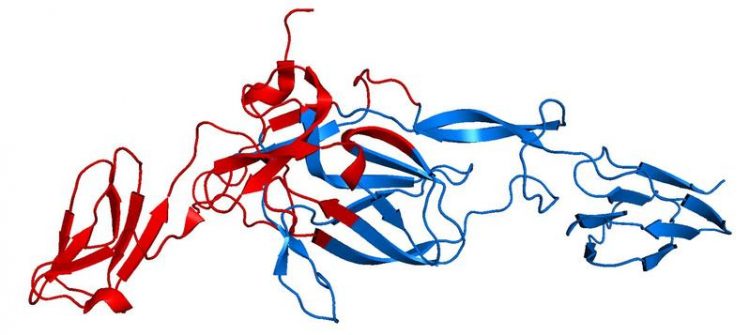Is a small artificially composed virus fragment the key to a Chikungunya vaccine?

Three dimensional structure of the Chikungunya virus envelope protein E2. Areas marked in red were used for the approaches to a vaccine. www.rcsb.org/pdb/explore/explore.do?structureId=3N44
The Chikungunya virus (CHIKV) is transmitted by Aedes mosquitoes and causes an infection in humans known as Chikungunya fever. CHIKV occurs in the tropical and subtropical parts of the world. Regions where it has already caused epidemics include Africa, territories around the Indian Ocean, Southeast Asia, and meanwhile also the Caribbean, Central America, and South America.
Around 1.2 million people are estimated to be infected so far during an epidemic in America. Since the Aedes albopictus mosquito, also known as Asian tiger mosquito, has now reached southern Europe and the USA, we are faced with further spreading of the virus. The Paul-Ehrlich-Institut has issued the regulation in 2007 that after returning from an endemic area, blood donors must be deferred from donating blood for at least two weeks to prevent an infection via the blood stream.
The disease is characterized by fever and severe joint pain, hence its name, which means “that which bends up”. In 30 to 40 percent of the cases, these joint pains can last several months or even up to several years.
Attempts at developing suitable vaccines have up to now been unsuccessful. To develop an effective vaccine, it is imperative to identify a suitable antigen structure of the virus which will create an effective immune response in humans. Previous approaches have used the entire E2 surface protein as a basis for the vaccine, partly in combination with other virus proteins. These proteins, however, have a relatively large structure, which would make commercial vaccine production difficult.
Professor Barbara Schnierle, head of the section “AIDS, New and Emerging Pathogens” of the division Virology at the Paul-Ehrlich-Institut and her team have investigated whether smaller more specific and less complex-to-be produced parts of E2 would suffice for conferring a protective immune response. Based on the three-dimensional structure of the protein, the researchers of the PEI selected different areas exposed on the surface to join them together, thus creating several artificial protein fragments.
After production in E. coli and purification, mice were immunized with these protein fragments, and their blood was examined for neutralizing antibodies later on. In this experiment, one fragment, described as sAB+, proved to be the most effective one to induce neutralizing antibodies. It was used to immunize mice which were then infected by the wild-type Chikungunya virus.
Compared with non-vaccinated animals, the mice treated showed significantly less virus RNA in the blood – a sign of partial immune protection. “”Our research work shows that single and artificially composed fragments of the Chikungunya virus surface protein may suffice to induce a partially protective immune response. We consider our vaccine approach as promising for further development””, said Professor Schnierle in her explanation of the research results.
Original publication
Weber C, Büchner SM, Schnierle BS (2015):
A Small Antigenic Determinant of the Chikungunya Virus E2 Protein Is Sufficient to Induce Neutralizing Antibodies which Are Partially Protective in Mice.
PLoS Negl Trop Dis 9: e0003684.
DOI:10.1371/journal.pntd.0003684
The Paul-Ehrlich-Institut, the Federal Institute for Vaccines and Biomedicines, in Langen near Frankfurt/Main is a senior federal authority reporting to the Federal Ministry of Health (Bundesministerium für Gesundheit, BMG). It is responsible for the research, assessment, and marketing authorisation of biomedicines for human use and immunological veterinary medicinal products. Its remit also includes the authorisation of clinical trials and pharmacovigilance, i.e. recording and evaluation of potential adverse effects.
Other duties of the institute include official batch control, scientific advice and inspections. In-house experimental research in the field of biomedicines and life science form an indispensable basis for the manifold tasks performed at the institute.
The Paul-Ehrlich-Institut, with its roughly 800 members of staff, also has advisory functions nationally (federal government, federal states (Länder)), and internationally (World Health Organisation, European Medicines Agency, European Commission, Council of Europe etc.).
http://journals.plos.org/plosntds/article?id=10.1371/journal.pntd.0003684 – Online Version of the Publication
Media Contact
All latest news from the category: Life Sciences and Chemistry
Articles and reports from the Life Sciences and chemistry area deal with applied and basic research into modern biology, chemistry and human medicine.
Valuable information can be found on a range of life sciences fields including bacteriology, biochemistry, bionics, bioinformatics, biophysics, biotechnology, genetics, geobotany, human biology, marine biology, microbiology, molecular biology, cellular biology, zoology, bioinorganic chemistry, microchemistry and environmental chemistry.
Newest articles

NASA: Mystery of life’s handedness deepens
The mystery of why life uses molecules with specific orientations has deepened with a NASA-funded discovery that RNA — a key molecule thought to have potentially held the instructions for…

What are the effects of historic lithium mining on water quality?
Study reveals low levels of common contaminants but high levels of other elements in waters associated with an abandoned lithium mine. Lithium ore and mining waste from a historic lithium…

Quantum-inspired design boosts efficiency of heat-to-electricity conversion
Rice engineers take unconventional route to improving thermophotovoltaic systems. Researchers at Rice University have found a new way to improve a key element of thermophotovoltaic (TPV) systems, which convert heat…



